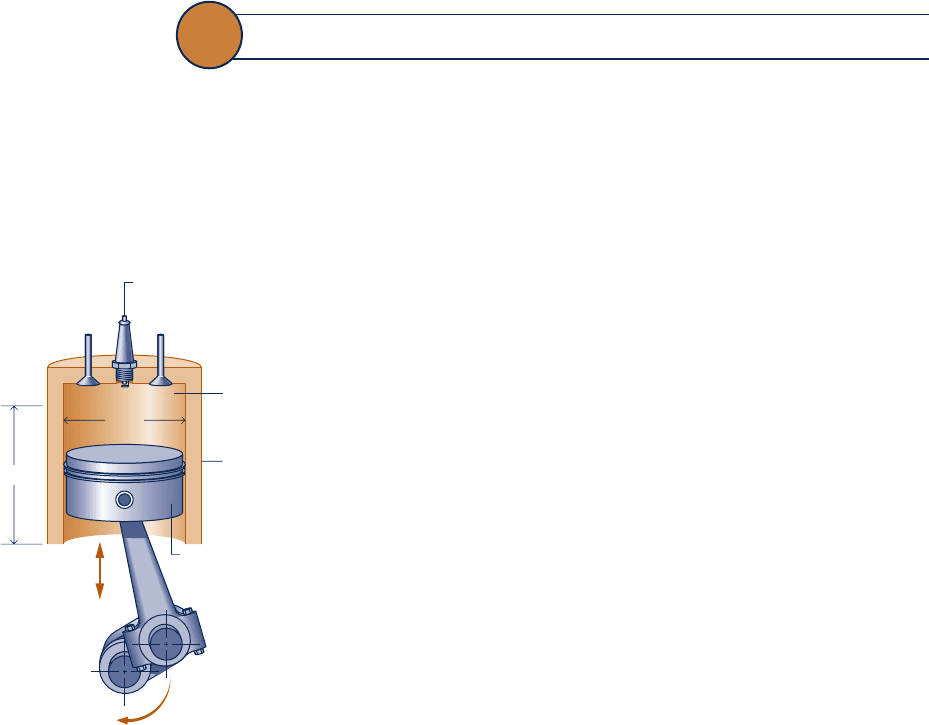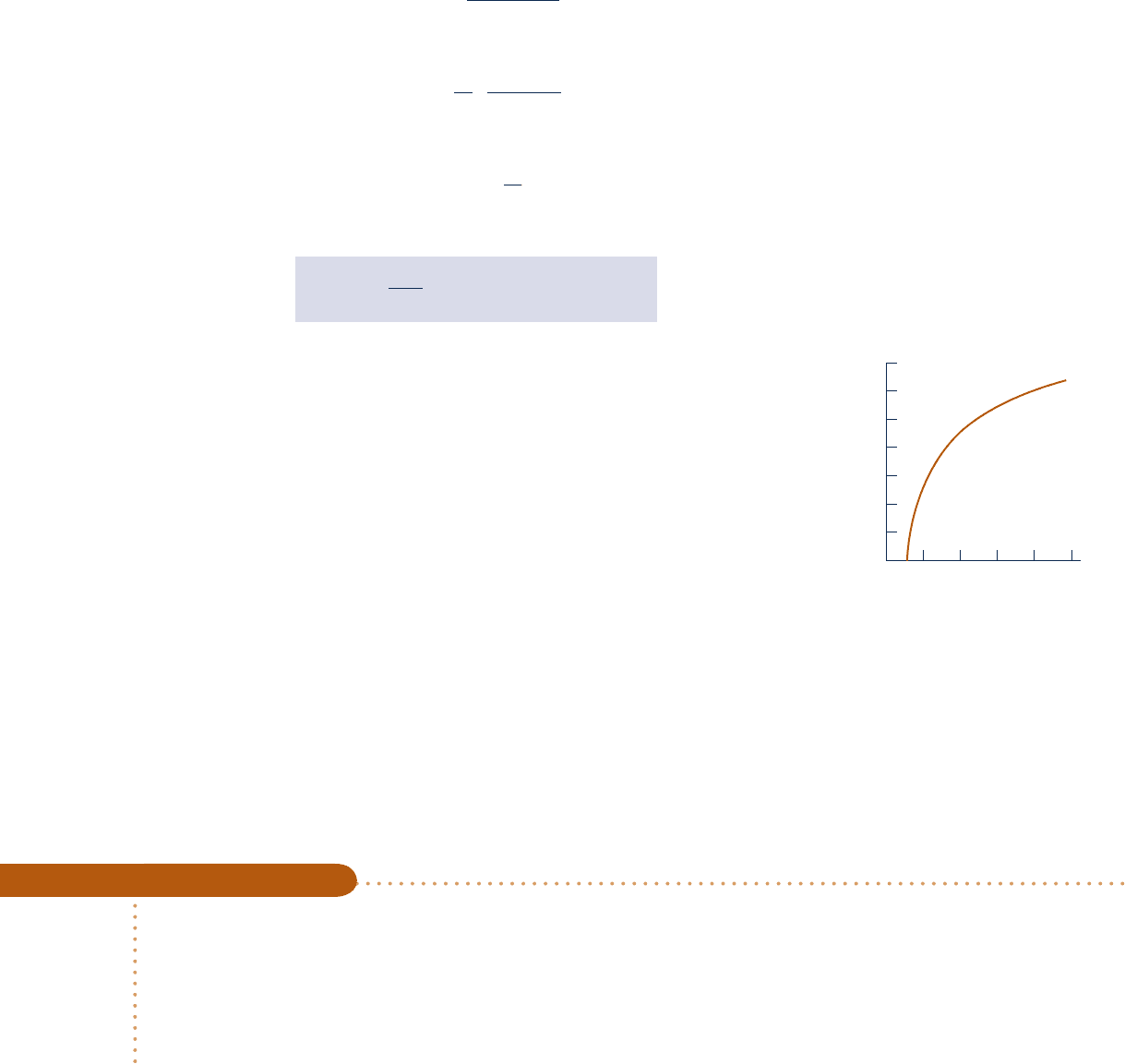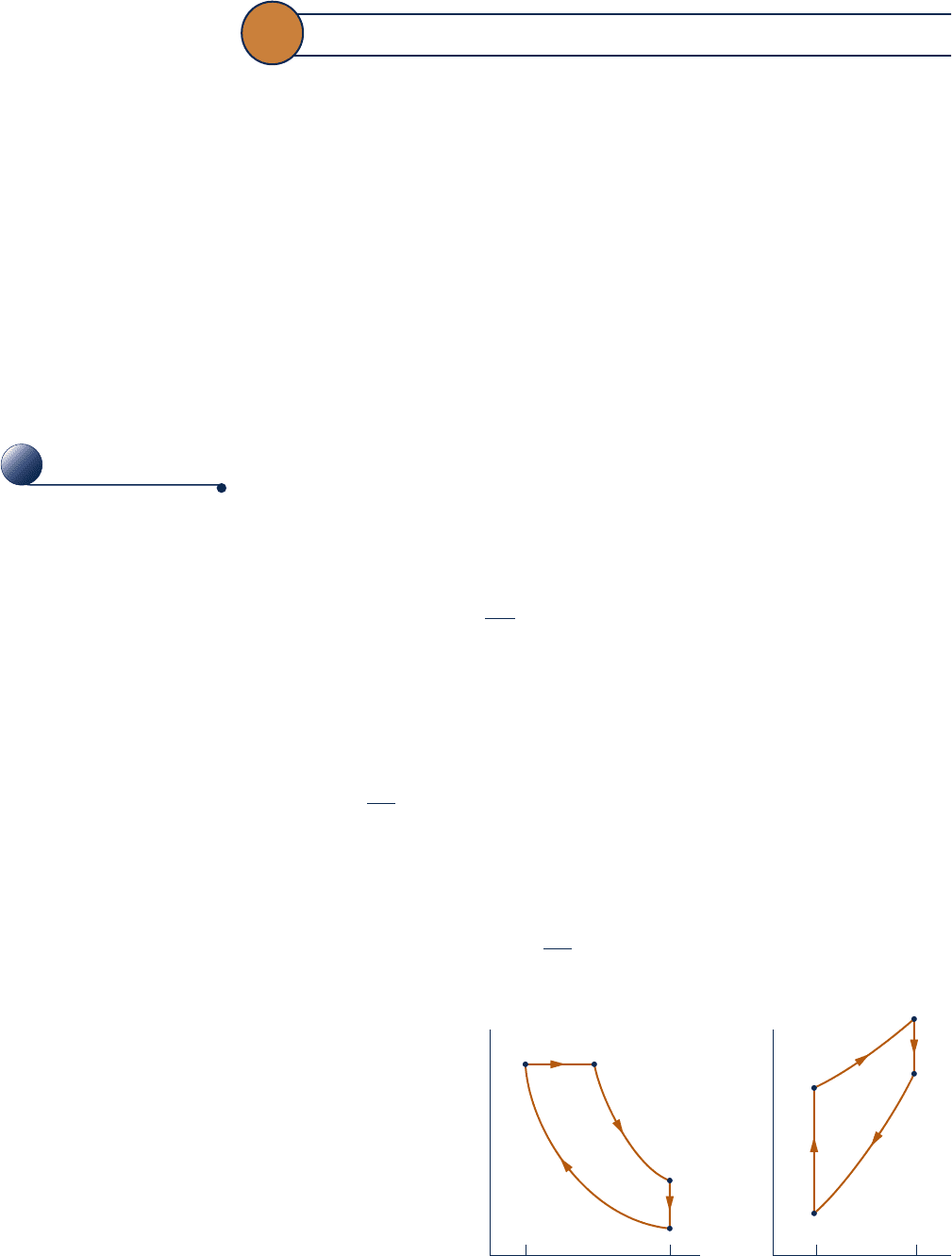Moran M.J., Shapiro H.N. Fundamentals of Engineering Thermodynamics
Подождите немного. Документ загружается.


Gas Power
Systems
9
When you complete your study of this chapter, you will be able to...
c
Perform air-standard analyses of internal combustion engines based on the Otto, Diesel,
and dual cycles, including:
c
sketching p–y and T–s diagrams and evaluating property data at principal states.
c
applying energy, entropy, and exergy balances.
c
determining net power output, thermal efficiency, and mean effective pressure.
c
Perform air-standard analyses of gas turbine power plants based on the Brayton cycle and
its modifications, including:
c
sketching T–s diagrams and evaluating property data at principal states.
c
applying mass, energy, entropy, and exergy balances.
c
determining net power output, thermal efficiency, back work ratio, and the effects of
compressor pressure ratio.
c
For subsonic and supersonic flows through nozzles and diffusers:
c
demonstrate understanding of the effects of area change, the effects of back pressure
on mass flow rate, and the occurrence of choking and normal shocks.
c
analyze the flow of ideal gases with constant specific heats.
LEARNING OUTCOMES
493
c09GasPowerSystems.indd Page 493 7/19/10 9:57:34 AM users-133c09GasPowerSystems.indd Page 493 7/19/10 9:57:34 AM users-133 /Users/users-133/Desktop/Ramakant_04.05.09/WB00113_R1:JWCL170/New/Users/users-133/Desktop/Ramakant_04.05.09/WB00113_R1:JWCL170/New

494 Chapter 9
Gas Power Systems
Considering Internal Combustion
Engines
This part of the chapter deals with internal combustion engines. Although most gas
turbines are also internal combustion engines, the name is usually applied to recip-
rocating internal combustion engines of the type commonly used in automobiles,
trucks, and buses. These engines differ from the power plants considered in Chap. 8
because the processes occur within reciprocating piston–cylinder arrangements and
not in interconnected series of different components.
Two principal types of reciprocating internal combustion engines are the spark-
ignition
engine and the compression-ignition engine. In a spark-ignition engine, a mix-
ture of fuel and air is ignited by a spark plug. In a compression-ignition engine, air
is compressed to a high enough pressure and temperature that combustion occurs
spontaneously when fuel is injected. Spark-ignition engines have advantages for appli-
cations requiring power up to about 225 kW (300 horsepower). Because they are
relatively light and lower in cost, spark-ignition engines are particularly suited for use
in automobiles. Compression-ignition engines are normally preferred for applications
when fuel economy and relatively large amounts of power are required (heavy trucks
and buses, locomotives and ships, auxiliary power units). In the middle range, spark-
ignition and compression-ignition engines are used.
9.1 Introducing Engine Terminology
Figure 9.1 is a sketch of a reciprocating internal combustion engine consisting of a
piston that moves within a cylinder fitted with two valves. The sketch is labeled with
some special terms. The bore of the cylinder is its diameter. The stroke is the distance
the piston moves in one direction. The piston is said to be at top dead center when
it has moved to a position where the cylinder volume is a minimum. This minimum
volume is known as the clearance volume. When the piston has moved to the position
of maximum cylinder volume, the piston is at bottom dead center. The volume swept
out by the piston as it moves from the top dead center to the bottom dead center
position is called the displacement volume. The compression ratio r is
defined as the volume at bottom dead center divided by the volume
at top dead center. The reciprocating motion of the piston is converted
to rotary motion by a crank mechanism.
In a four-stroke internal combustion engine, the piston executes four
distinct strokes within the cylinder for every two revolutions of the
crankshaft. Fig. 9.2 gives a pressure–volume diagram such as might be
displayed electronically.
1. With the intake valve open, the piston makes an intake stroke to
draw a fresh charge into the cylinder. For spark-ignition engines, the
charge is a combustible mixture of fuel and air. Air alone is the
charge in compression-ignition engines.
2. With both valves closed, the piston undergoes a compression stroke,
raising the temperature and pressure of the charge. This requires
work input from the piston to the cylinder contents. A combustion
process is then initiated, resulting in a high-pressure, high-temperature
gas mixture. Combustion is induced near the end of the compression
stroke in spark-ignition engines by the spark plug. In compression-
ignition engines, combustion is initiated by injecting fuel into the
hot compressed air, beginning near the end of the compression
stroke and continuing through the first part of the expansion.
spark-ignition
compression-ignition
compression ratio
Spark plug or
fuel injector
Piston
Stroke
Bore
Crank mechanism
Reciprocating
motion
Top
dead center
Bottom
dead center
Rotary
motion
Valve
Clearance
volume
Cylinder
wall
Fig. 9.1 Nomenclature for reciprocating
piston–cylinder engines.
c09GasPowerSystems.indd Page 494 7/19/10 9:57:35 AM users-133c09GasPowerSystems.indd Page 494 7/19/10 9:57:35 AM users-133 /Users/users-133/Desktop/Ramakant_04.05.09/WB00113_R1:JWCL170/New/Users/users-133/Desktop/Ramakant_04.05.09/WB00113_R1:JWCL170/New

3. A power stroke follows the compression stroke, during which the gas
mixture expands and work is done on the piston as it returns to bot-
tom dead center.
4. The piston then executes an exhaust stroke in which the burned gases
are purged from the cylinder through the open exhaust valve.
Smaller engines operate on two-stroke cycles. In two-stroke engines, the
intake, compression, expansion, and exhaust operations are accom-
plished in one revolution of the crankshaft. Although internal combus-
tion engines undergo mechanical cycles, the cylinder contents do not
execute a thermodynamic cycle, for matter is introduced with one com-
position and is later discharged at a different composition.
A parameter used to describe the performance of reciprocating pis-
ton engines is the mean effective pressure, or mep. The mean effective
pressure
is the theoretical constant pressure that, if it acted on the piston
during the power stroke, would produce the same net work as actually
developed in one cycle. That is
mep 5
net work for one cycl
e
displacement volume
(9.1)
For two engines of equal displacement volume, the one with a higher
mean effective pressure would produce the greater net work and, if the
engines run at the same speed, greater power.
AIR-STANDARD ANALYSIS. A detailed study of the performance of a recip-
rocating internal combustion engine would take into account many features. These
would include the combustion process occurring within the cylinder and the effects
of irreversibilities associated with friction and with pressure and temperature gradi-
ents. Heat transfer between the gases in the cylinder and the cylinder walls and the
work required to charge the cylinder and exhaust the products of combustion also
would be considered. Owing to these complexities, accurate modeling of reciprocating
internal combustion engines normally involves computer simulation. To conduct ele-
mentary thermodynamic analyses of internal combustion engines, considerable sim-
plification is required. One procedure is to employ an air-standard analysis having the
following elements:
c A fixed amount of air modeled as an ideal gas is the working fluid. See Table 9.1
for a review of ideal gas relations.
c The combustion process is replaced by a heat transfer from an external source.
c There are no exhaust and intake processes as in an actual engine. The cycle is
completed by a constant-volume heat transfer process taking place while the piston
is at the bottom dead center position.
c All processes are internally reversible.
In addition, in a cold air-standard analysis, the specific heats are assumed constant at
their ambient temperature values. With an air-standard analysis, we avoid dealing with
the complexities of the combustion process and the change of composition during
combustion. A comprehensive analysis requires that such complexities be considered,
however. For a discussion of combustion, see Chap. 13.
Although an air-standard analysis simplifies the study of internal combustion
engines considerably, values for the mean effective pressure and operating tempera-
tures and pressures calculated on this basis may depart significantly from those of
actual engines. Accordingly, air-standard analysis allows internal combustion engines
to be examined only qualitatively. Still, insights concerning actual performance can
result with such an approach.
Top dead
center
Intake
valve
opens,
exhaust
valve
closes
Exhaust valve
opens
Exhaust
Compression
Power
Intake valve
closes
Intake
Volume
Bottom
dead center
p
X
X
X
Combustion initiated
X
Fig. 9.2 Pressure–volume diagram for a
reciprocating internal combustion engine.
air-standard analysis:
internal combustion engines
cold air-standard analysis
9.1 Introducing Engine Terminology 495
mean effective pressure
c09GasPowerSystems.indd Page 495 7/19/10 9:57:35 AM users-133c09GasPowerSystems.indd Page 495 7/19/10 9:57:35 AM users-133 /Users/users-133/Desktop/Ramakant_04.05.09/WB00113_R1:JWCL170/New/Users/users-133/Desktop/Ramakant_04.05.09/WB00113_R1:JWCL170/New

496 Chapter 9
Gas Power Systems
Ideal Gas Model Review
Equations of state:
py 5 RT (3.32)
pV 5 mRT (3.33)
Changes in u and h:
u(T
2
) 2 u(T
1
) 5
#
T
2
T
1
c
y
(T) dT
(3.40)
h(T
2
) 2 h(T
1
) 5
#
T
2
T
1
c
p
(T ) dT
(3.43)
Constant Specific Heats Variable Specific Heats
u(T
2
) 2 u(T
1
) 5 c
y
(T
2
2 T
1
) (3.50)
h(T
2
) 2 h(T
1
) 5 c
p
(T
2
2 T
1
) (3.51)
See Tables A-20, 21 for data.
u(T ) and h(T ) are evaluated from appropriate
tables: Tables A-22 for air (mass basis) and
A-23 for other gases (molar basis).
Changes in s:
s(T
2
, y
2
) 2 s(T
1
, y
1
) 5
#
T
2
T
1
c
y
(T )
dT
T
1 R ln
y
2
y
1
(6.17)
s(T
2
, p
2
) 2 s(T
1
, p
1
) 5
#
T
2
T
1
c
p
(T )
dT
T
2 R ln
p
2
p
1
(6.18)
Constant Specific Heats Variable Specific Heats
s(T
2
, y
2
) 2 s(T
1
, y
1
) 5
c
y
ln
T
2
T
1
1 R ln
y
2
y
1
(6.21)
s(T
2
, p
2
) 2 s(T
1
, p
1
) 5
s8(T
2
) 2 s8(T
1
) 2 R ln
p
2
p
1
(6.20a)
s(T
2
, p
2
) 2 s(T
1
, p
1
) 5
c
p
ln
T
2
T
1
2 R ln
p
2
p
1
(6.22)
See Tables A-20, 21 for data.
where s°(T) is evaluated from appropriate
tables: Tables A-22 for air (mass basis) and
A-23 for other gases (molar basis).
Relating states of equal specific entropy: Ds 5 0:
Constant Specific Heats Variable Specific Heats — Air Only
T
2
T
1
5 a
p
2
p
1
b
(k 2 1)
/
k
(6.43)
T
2
T
1
5 a
y
1
y
2
b
k2 1
(6.44)
p
2
p
1
5 a
y
1
y
2
b
k
(6.45)
where k 5 c
p
/c
y
is given in Tables A-20
for several gases.
p
2
p
1
5
p
r2
p
r1
(air only) (6.41)
y
2
y
1
5
y
r2
y
r1
(air only) (6.42)
where p
r
and y
r
are provided for air
in Tables A-22.
TABLE 9.1
ENERGY & ENVIRONMENT Nature needed 500 million years to create the
world’s stock of readily accessible oil, but some observers predict we will consume
much of what’s left within the next 50 years. Still, the important issue, they say, is
not when the world runs out of oil, but when production will peak. After that, unless demand is
reduced, oil prices will rise. This will end the era of cheap oil we have enjoyed for decades and
pose challenges for society.
c09GasPowerSystems.indd Page 496 7/19/10 9:57:36 AM users-133c09GasPowerSystems.indd Page 496 7/19/10 9:57:36 AM users-133 /Users/users-133/Desktop/Ramakant_04.05.09/WB00113_R1:JWCL170/New/Users/users-133/Desktop/Ramakant_04.05.09/WB00113_R1:JWCL170/New

9.2 Air-Standard Otto Cycle
In the remainder of this part of the chapter, we consider three cycles that adhere to
air-standard cycle idealizations: the Otto, Diesel, and dual cycles. These cycles differ
from each other only in the way the heat addition process that replaces combustion
in the actual cycle is modeled.
The air-standard Otto cycle is an ideal cycle that assumes heat addition occurs instan-
taneously while the piston is at top dead center. The Otto cycle is shown on the p–y
and T–s diagrams of Fig. 9.3. The cycle consists of four internally reversible processes
in series:
c Process 1–2 is an isentropic compression of the air as the piston moves from bot-
tom dead center to top dead center.
c Process 2–3 is a constant-volume heat transfer to the air from an external source
while the piston is at top dead center. This process is intended to represent the
ignition of the fuel–air mixture and the subsequent rapid burning.
c Process 3–4 is an isentropic expansion (power stroke).
c Process 4–1 completes the cycle by a constant-volume process in which heat is
rejected from the air while the piston is at bottom dead center.
Since the air-standard Otto cycle is composed of internally reversible processes,
areas on the T–s and p–y diagrams of Fig. 9.3 can be interpreted as heat and work,
The rate at which any well can produce oil typically rises to a maximum and then, when about
half the oil has been pumped out, begins to fall as the remaining oil becomes increasingly difficult
to extract. Using this model for the world oil supply as a whole, economists predict a peak in oil
production by 2020, or even sooner. If we don’t plan for the future, this could lead to shortages,
higher fuel prices at the pump, and political repercussions.
The reality is that oil has become our Achilles heel with regard to energy. Transportation
accounts for about 70% of current U.S. oil consumption, while nearly 60% of the oil we use is
imported. Domestic oil production peaked in the 1970s and has declined since then. There have
been calls for greater production from our offshore and wilderness areas, but analysts say this
will not be a solution, for oil from many such locations will meet only a few months of current
demand. Moreover, ecologists warn about environmental damage owing to huge oil spills; col-
lateral soil, water, and air pollution; and other adverse effects related to oil extraction, delivery,
and use. Many think a better way forward is to wean ourselves from relying on oil for transporta-
tion by using strategies for economizing fuel (see www.fueleconomy.gov), using biofuels such as
cellulosic ethanol, and driving hybrid-electric or all-electric vehicles.
Otto cycle
T
s
2
1
2′
3′
3
v = c
v = c
4
b a
p
v
2
3
4
s = c
s = c
1
a b
Fig. 9.3 p–
y
and T–s diagrams of the
air-standard Otto cycle.
TAKE NOTE...
For internally reversible
processes of closed sys-
tems, see Secs. 2.2.5 and
6.6.1 for discussions of
area interpretations of
work and heat transfer on
p–y and T–s diagrams,
respectively.
9.2 Air-Standard Otto Cycle 497
c09GasPowerSystems.indd Page 497 7/19/10 9:57:38 AM users-133c09GasPowerSystems.indd Page 497 7/19/10 9:57:38 AM users-133 /Users/users-133/Desktop/Ramakant_04.05.09/WB00113_R1:JWCL170/New/Users/users-133/Desktop/Ramakant_04.05.09/WB00113_R1:JWCL170/New

498 Chapter 9 Gas Power Systems
respectively. On the T–s diagram, area 2–3–a–b–2 represents heat added per unit of
mass and area 1–4–a–b–1 the heat rejected per unit of mass. On the p–y diagram,
area 1–2–a–b–1 represents work input per unit of mass during the compression pro-
cess and area 3–4–b–a–3 is work done per unit of mass in the expansion process. The
enclosed area of each figure can be interpreted as the net work output or, equiva-
lently, the net heat added.
CYCLE ANALYSIS. The air-standard Otto cycle consists of two processes in which
there is work but no heat transfer, Processes 1–2 and 3–4, and two processes in which
there is heat transfer but no work, Processes 2–3 and 4–1. Expressions for these
energy transfers are obtained by reducing the closed system energy balance assuming
that changes in kinetic and potential energy can be ignored. The results are
W
12
m
5 u
2
2 u
1
,
W
34
m
5 u
3
2 u
4
Q
23
m
5 u
3
2 u
2
,
Q
41
m
5 u
4
2 u
1
(9.2)
Carefully note that in writing Eqs. 9.2, we have departed from our usual sign conven-
tion for heat and work. Thus, W
12
/m is a positive number representing the work input
during compression and Q
41
/m is a positive number representing the heat rejected in
Process 4–1. The net work of the cycle is expressed as
W
cycle
m
5
W
34
m
2
W
12
m
5 1u
3
2 u
4
22 1u
2
2 u
1
2
Alternatively, the net work can be evaluated as the net heat added
W
cycle
m
5
Q
23
m
2
Q
41
m
5 1u
3
2 u
2
22 1u
4
2 u
1
2
which, on rearrangement, can be placed in the same form as the previous expression
for net work.
The thermal efficiency is the ratio of the net work of the cycle to the heat added.
h 5
1
u
3
2 u
2
2
2
1
u
4
2 u
1
2
u
3
2 u
2
5 1 2
u
4
2 u
1
u
3
2 u
2
(9.3)
When air table data are used to conduct an analysis involving an air-standard Otto
cycle, the specific internal energy values required by Eq. 9.3 can be obtained from
Table A-22 or A-22E as appropriate. The following relationships based on Eq. 6.42
apply for the isentropic processes 1–2 and 3–4
y
r2
5 y
r1
a
V
2
V
1
b5
y
r1
r
(9.4)
y
r4
5 y
r3
a
V
4
V
3
b
5 ry
r3
(9.5)
where r denotes the compression ratio. Note that since V
3
5 V
2
and V
4
5 V
1
, r 5
V
1
/V
2
5 V
4
/V
3
The parameter y
r
is tabulated versus temperature for air in Tables A-22.
When the Otto cycle is analyzed on a cold air-standard basis, the following expres-
sions based on Eq. 6.44 would be used for the isentropic processes in place of Eqs. 9.4
and 9.5, respectively
T
2
T
1
5 a
V
1
V
2
b
k21
5 r
k21
1constant k2
(9.6)
T
4
T
3
5 a
V
3
V
4
b
k21
5
1
r
k21
1constant k2
(9.7)
where k is the specific heat ratio, k 5 c
p
/c
y
.
TAKE NOTE...
When analyzing air-standard
cycles, it is frequently con-
venient to regard all work
and heat transfers as
positive quantities and
write the energy balance
accordingly.
compression ratio
A
A
Otto_Cycle
A.27 – Tabs a & b
c09GasPowerSystems.indd Page 498 7/19/10 9:57:38 AM users-133c09GasPowerSystems.indd Page 498 7/19/10 9:57:38 AM users-133 /Users/users-133/Desktop/Ramakant_04.05.09/WB00113_R1:JWCL170/New/Users/users-133/Desktop/Ramakant_04.05.09/WB00113_R1:JWCL170/New

EFFECT OF COMPRESSION RATIO ON PERFORMANCE. By referring to
the T–s diagram of Fig. 9.3, we can conclude that the Otto cycle thermal efficiency
increases as the compression ratio increases. An increase in the compression ratio
changes the cycle from 1–2–3–4–1 to 1–29–39–4–1. Since the average temperature of
heat addition is greater in the latter cycle and both cycles have the same heat rejection
process, cycle 1–29–39–4–1 would have the greater thermal efficiency. The increase in
thermal efficiency with compression ratio is also brought out simply by the following
development on a cold air-standard basis. For constant c
y
, Eq. 9.3 becomes
h 5 1 2
c
y
1T
4
2 T
1
2
c
y
1T
3
2 T
2
2
On rearrangement
h 5 1 2
T
1
T
2
a
T
4
/
T
1
2 1
T
3
/
T
2
2 1
b
From Eqs. 9.6 and 9.7 above, T
4
/T
1
5 T
3
/T
2
,
so
h 5 1 2
T
1
T
2
Finally, introducing Eq. 9.6
h 5 1 2
1
r
k21
1cold-air standard basis2
(9.8)
Equation 9.8 indicates that the cold air-standard Otto cycle thermal efficiency is a
function of compression ratio and k. This relationship is shown in Fig. 9.4 for k 5 1.4,
representing ambient air.
The foregoing discussion suggests that it is advantageous for internal combustion
engines to have high compression ratios, and this is the case. The possibility of autoigni-
tion, or “knock,” places an upper limit on the compression ratio of spark-ignition engines,
however. After the spark has ignited a portion of the fuel–air mixture, the rise in pressure
accompanying combustion compresses the remaining charge. Autoignition can occur if
the temperature of the unburned mixture becomes too high before the mixture is con-
sumed by the flame front. Since the temperature attained by the air–fuel mixture during
the compression stroke increases as the compression ratio increases, the likelihood of
autoignition occurring increases with the compression ratio. Autoignition may result in
high-pressure waves in the cylinder (manifested by a knocking or pinging sound) that
can lead to loss of power as well as engine damage.
Owing to performance limitations, such as autoignition, the compression ratios of spark-
ignition engines using the unleaded fuel required today because of air pollution concerns
are in the range 9.5 to 11.5, approximately. Higher compression ratios can be achieved in
compression-ignition engines because only air is compressed. Compression ratios in the
range 12 to 20 are typical. Compression-ignition engines also can use less refined fuels hav-
ing higher ignition temperatures than the volatile fuels required by spark-ignition engines.
In the next example, we illustrate the analysis of the air-standard Otto cycle. Results
are compared with those obtained on a cold air-standard basis.
0
10
1062840
Compression ratio, r
η (%)
70
20
30
40
50
60
Fig. 9.4 Thermal efficiency
of the cold air-standard Otto
cycle, k 5 1.4.
Analyzing the Otto Cycle
c c c c EXAMPLE 9.1 c
The temperature at the beginning of the compression process of an air-standard Otto cycle with a compression
ratio of 8 is 5408R, the pressure is 1 atm, and the cylinder volume is 0.02 ft
3
. The maximum temperature during
the cycle is 36008R. Determine (a) the temperature and pressure at the end of each process of the cycle, (b) the
thermal efficiency, and (c) the mean effective pressure, in atm.
9.2 Air-Standard Otto Cycle 499
c09GasPowerSystems.indd Page 499 7/19/10 9:57:40 AM users-133c09GasPowerSystems.indd Page 499 7/19/10 9:57:40 AM users-133 /Users/users-133/Desktop/Ramakant_04.05.09/WB00113_R1:JWCL170/New/Users/users-133/Desktop/Ramakant_04.05.09/WB00113_R1:JWCL170/New

500 Chapter 9
Gas Power Systems
SOLUTION
Known:
An air-standard Otto cycle with a given value of compression ratio is executed with specified conditions
at the beginning of the compression stroke and a specified maximum temperature during the cycle.
Find: Determine the temperature and pressure at the end of each process, the thermal efficiency, and mean
effective pressure, in atm.
Schematic and Given Data:
Engineering Model:
1.
The air in the piston–cylinder assembly is the closed system.
2. The compression and expansion processes are adiabatic.
3. All processes are internally reversible.
4. The air is modeled as an ideal gas.
5. Kinetic and potential energy effects are negligible.
Analysis:
(a)
The analysis begins by determining the temperature, pressure, and specific internal energy at each principal
state of the cycle. At T
1
5 5408R, Table A-22E gives u
1
5 92.04 Btu/lb and y
r1
5 144.32.
For the isentropic compression Process 1–2
y
r2
5
V
2
V
1
y
r1
5
y
r1
r
5
14
4.32
8
5 18.04
Interpolating with y
r2
in Table A-22E, we get T
2
5 12128R and u
2
5 211.3 Btu/lb. With the ideal gas equation of
state
p
2
5 p
1
T
2
T
1
V
1
V
2
5 11 atm2
a
12128R
5408R
b
8 5 17.96 at
m
The pressure at state 2 can be evaluated alternatively by using the isentropic relationship, p
2
5 p
1
(p
r2
/p
r1
)
.
Since Process 2–3 occurs at constant volume, the ideal gas equation of state gives
p
3
5 p
2
T
3
T
2
5 117.96 atm2
a
36008R
12128R
b
5 53.3 at
m
At T
3
5 36008R, Table A-22E gives u
3
5 721.44 Btu/lb and y
r3
5 0.6449.
For the isentropic expansion process 3–4
y
r4
5 y
r3
V
4
V
3
5 y
r3
V
1
V
2
5 0.64491825 5.16
T
s
3
v
= c
v
= c
4
p
v
2
3
4
s = c
s = c
1
T
3
= 3600°R
T
3
= 3600°R
= 8
V
1
––
V
2
1
2
T
1
= 540°R
Fig. E9.1
c09GasPowerSystems.indd Page 500 7/19/10 9:57:41 AM users-133c09GasPowerSystems.indd Page 500 7/19/10 9:57:41 AM users-133 /Users/users-133/Desktop/Ramakant_04.05.09/WB00113_R1:JWCL170/New/Users/users-133/Desktop/Ramakant_04.05.09/WB00113_R1:JWCL170/New

Interpolating in Table A-22E with y
r4
gives T
4
5 18788R, u
4
5 342.2 Btu/lb. The pressure at state 4 can be found
using the isentropic relationship p
4
5 p
3
(p
r4
/p
r3
)
or the ideal gas equation of state applied at states 1 and 4. With
V
4
5 V
1
, the ideal gas equation of state gives
p
4
5 p
1
T
4
T
1
5 11 atm2 a
18788R
5408R
b
5 3.48 at
m
(b) The thermal efficiency is
h 5 1 2
Q
41
/
m
Q
23
/
m
5 1 2
u
4
2 u
1
u
3
2 u
2
5 1 2
342.2 2 92.04
721.44 2 211.
3
5 0.51 151%2
(c) To evaluate the mean effective pressure requires the net work per cycle. That is
W
c
y
cle
5 m
31
u
3
2 u
4
2
2
1
u
2
2 u
1
24
where m is the mass of the air, evaluated from the ideal gas equation of state as follows:
m 5
p
1
V
1
1
R
/
M
2
T
1
5
114.696 lbf
/
in.
2
2
Z
144 in.
2
/
ft
2
Z
10.02 ft
3
2
a
1545
28.97
ft ? lbf
lb ? 8R
b
15408R2
5 1.47 3 1
0
23
lb
Inserting values into the expression for W
cycle
W
c
y
cle
5 11.47 3 10
23
lb231721.44 2 342.222 1211.3 2 92.0424 Btu
/
lb
5
0
.
38
2 Btu
The displacement volume is V
1
2 V
2
,
so the mean effective pressure is given by
mep 5
W
cycle
V
1
2 V
2
5
W
cycle
V
1
1
1 2 V
2
/
V
1
2
5
0.382 Btu
1
0.02 ft
3
21
1 2 1
/
8
2
`
778 ft ? lbf
1 Btu
``
1 ft
2
144 in.
2
`
5 11
8
l
b
f
/
in
.
2
5
8.03
at
m
➊ This solution utilizes Table A-22E for air, which accounts explicitly for the variation of the specific heats with
temperature. A solution also can be developed on a cold air-standard basis in
which constant specific heats are assumed. This solution is left as an exercise,
but for comparison the results are presented for the case k 5 1.4 in the fol-
lowing table:
Cold Air-Standard Analysis,
Parameter Air-Standard Analysis k 5 1.4
T
2
12128R 12418R
T
3
36008R 36008R
T
4
18788R 15678R
h 0.51 (51%) 0.565 (56.5%)
mep 8.03 atm 7.05 atm
➊
Ability to…
❑
sketch the Otto cycle p–y
and T–s diagrams.
❑
evaluate temperatures and
pressures at each principal
state and retrieve necessary
property data.
❑
calculate thermal efficiency
and mean effective pressure.
✓
Skills Developed
Determine the heat addition and the heat rejection for the cycle,
each in Btu. Ans. Q
23
5 0.750 Btu, Q
41
5 0.368 Btu.
9.2 Air-Standard Otto Cycle 501
c09GasPowerSystems.indd Page 501 7/19/10 9:57:42 AM users-133c09GasPowerSystems.indd Page 501 7/19/10 9:57:42 AM users-133 /Users/users-133/Desktop/Ramakant_04.05.09/WB00113_R1:JWCL170/New/Users/users-133/Desktop/Ramakant_04.05.09/WB00113_R1:JWCL170/New

502 Chapter 9
Gas Power Systems
Diesel cycle
9.3 Air-Standard Diesel Cycle
The air-standard Diesel cycle is an ideal cycle that assumes heat addition occurs dur-
ing a constant-pressure process that starts with the piston at top dead center. The
Diesel cycle is shown on p–y and T–s diagrams in Fig. 9.5. The cycle consists of four
internally reversible processes in series. The first process from state 1 to state 2 is the
same as in the Otto cycle: an isentropic compression. Heat is not transferred to the
working fluid at constant volume as in the Otto cycle, however. In the Diesel cycle,
heat is transferred to the working fluid at constant pressure. Process 2–3 also makes
up the first part of the power stroke. The isentropic expansion from state 3 to state
4 is the remainder of the power stroke. As in the Otto cycle, the cycle is completed
by constant-volume Process 4–1 in which heat is rejected from the air while the pis-
ton is at bottom dead center. This process replaces the exhaust and intake processes
of the actual engine.
Since the air-standard Diesel cycle is composed of internally reversible processes,
areas on the T–s and p–y diagrams of Fig. 9.5 can be interpreted as heat and work,
respectively. On the T–s diagram, area 2–3–a–b–2 represents heat added per unit of
mass and area 1–4–a–b–1 is heat rejected per unit of mass. On the p–y diagram,
area 1–2–a–b–1 is work input per unit of mass during the compression process. Area
2–3–4–b–a–2 is the work done per unit of mass as the piston moves from top dead
center to bottom dead center. The enclosed area of each figure is the net work output,
which equals the net heat added.
CYCLE ANALYSIS. In the Diesel cycle the heat addition takes place at constant
pressure. Accordingly, Process 2–3 involves both work and heat. The work is given by
W
23
m
5
#
3
2
p dy 5 p
2
1y
3
2 y
2
2
(9.9)
The heat added in Process 2–3 can be found by applying the closed system energy
balance
m
1
u
3
2 u
2
2
5
Q
2
3
2 W
2
3
Introducing Eq. 9.9 and solving for the heat transfer
Q
23
m
5 1u
3
2 u
2
21 p1y
3
2 y
2
25 1u
3
1 py
3
22 1u
2
1 py
2
2
5 h
3
2 h
2
(9.10)
where the specific enthalpy is introduced to simplify the expression. As in the Otto
cycle, the heat rejected in Process 4–1 is given by
Q
41
m
5 u
4
2 u
1
Fig. 9.5 p–y and T–s
diagrams of the air-standard
Diesel cycle.
T
s
3
p = c
v
= c
4
p
v
32
s = c
s = c
1
4
1
2
aa bb
A
A
Diesel_Cycle
A.28 – Tabs a & b
c09GasPowerSystems.indd Page 502 7/19/10 9:57:45 AM users-133c09GasPowerSystems.indd Page 502 7/19/10 9:57:45 AM users-133 /Users/users-133/Desktop/Ramakant_04.05.09/WB00113_R1:JWCL170/New/Users/users-133/Desktop/Ramakant_04.05.09/WB00113_R1:JWCL170/New
